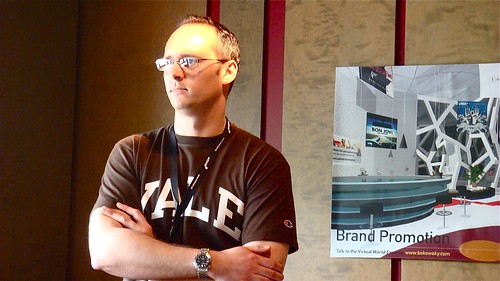Nic started with some definitions:
- Registered accounts – awareness metric
- Unique accounts – ‚cleaner‘ awareness (individual accounts)
- Active accounts – engagement metric (everone who was logged in in the last month)
- Concurrent accounts – live metric (users logged in at any given time)
- Premium accounts – value metric
Kid virtual worlds (0-10 years)
Examples from this segment:
- Biggest one and oldest one: Neopets (45 million accounts), started in 2004
- New: Barbie Girls (12m at the moment)
- Upcoming: Lego Universe (this is about user generated content as Lego always stood for this)
There are 400 million kids registered in this segment and thus it’s important.
He then showed a demo video of Lego universe which indeed looked impressive. It has user generated content, it has games included and much more. It’s a hybrid product between virtual worlds and a gaming part. There is a good probability that it also might be attractive to older people (technical lego).
Growth in the 0-10 year old age:
- More (toy) brands going virtual
- Teaching & Education
- Early relationship building
Neopets especially shows a good example of this as kids like to look even after a virtual pet and care for it. But meant is both, virtual and real relationships.
10-20 years old
This is the biggest segment. The major ones here are:
- Habbo Hotel (90 million accounts. Growth is slowing down though and they are also around for quite a long time, accumulating users)
- Club Penguin (17m). Everybody wants to be the next Club Penguin
- Whyville (3 million, educational based world)
- Gaia Online (12m)
- Stardoll (17m, 8m uniques)
- IMVU (20m but has issues at the moment)
- WeeWorld (21m)
- vSide
Problem in these areas are always to moderate the world. But this is an issue if worlds start to grow. Hence there is lots of work going on in trying to automate these things.
He then showed vSide what he calls a vertical world (themed by specific interests, music in vSide). Second Life OTOH is a generalist world. Vertical worlds do better in retention rates because you know why you are in there and people have something in common straight away.
Playstation Home is seen more as a glue by Nic as it’s in the middle between games. You can meet people in there and then go out to play a game. Now there’s a new concept of virtual goods in there. (The graphics are fantastic according to Nic who is a beta tester). Should it finally launch it’s probably very popular.
Growth in the 10-20 year old sector:
- Live Events – music
- Education
- Avatar customisation
- Clothing and Fashion
- Real world social networking integration
- Virtual goods/gifting
20-30 years old
- vMTV (1,5m)
- Kaneva (1m)
- ActiveWorlds (1m)
Many worlds upcoming:
Twinity, Vivaty, Empire of Sports, Near, Amazing Worlds
For the area close to 30 years old we find many Mirror World. It’s moving into a space you recognize, like a virtual London or New York. This might be something Google is heading to. Problem with Mirror Worlds is though that it takes quite a time to recreate these places. But more and more technical tools are developed such as laser scanners which can scan buildings and understand text.
We then saw a video of one Mirror World: Amazing World. After that we saw Mycosm which unfortunately did not show what they really wanna do but looked nice :-) According to Nic it’s supposed to be high-end generation of digital items.
Growth in the 20-30 year old sector:
- Vertical Worlds (theme based)
- Virtual goods / gifting
- Media convergence (like L Word in SL)
- Business & pleasure usage
- Inter/outer operability
About interoperability
He says nobody is asking for it but he sees applications in kids worlds. Once you are too old for one world you might join the next one and your account actually might be bought be the new vendor from the old one.
Virtual retailing
Examples of marketing doing on a separate island is not working usually (barrier of going there). His approach was to partner with existing companies in Second Life. The success was quite good as they penetrated 12% of the active SL user base.
30+ sector
He sees Second Life there mostly alone. HiPiHi, eRepublic and Kinset might be but the problem is the vast majority of content inside Second Life. Content is what people drives into it.
Growth:
- Enterprise usage
- Inter-world apps
- Mirror worlds
- Augmented Reality
